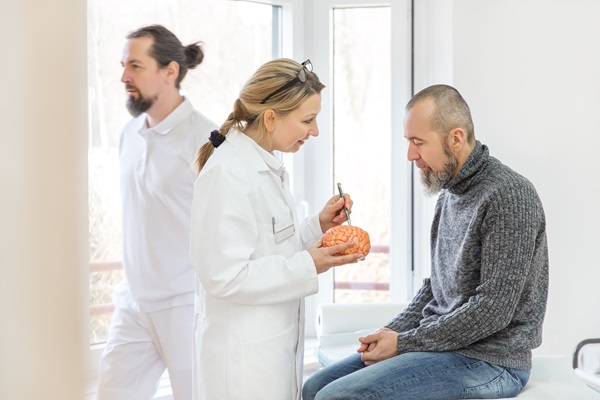Understanding the Risks and Prevention of Brain Aneurysms

Brain aneurysms are bulges that develop in the blood vessels in and around the brain. Though most do not cause harm, some can become enlarged, and the consequences of a rupture are severe, even life-threatening. Therefore, it is important to understand your risk of a brain aneurysm, symptoms to watch for, and steps you can take to help prevent one.
What is a brain aneurysm?
Also known as a cerebral aneurysm, brain aneurysms are bulges in weak areas of the blood vessels in the brain's arteries. The constant blood flow pressure can push against the weakened section of the artery wall, causing the section to bulge outward in a blistering bump. They are especially common at the branching points of arteries, where the walls tend to be weaker.
The majority of cerebral aneurysms are small and do not cause symptoms. However, if it enlarges, it can threaten nearby nerves, causing symptoms or burst open, leading to bleeding in the brain, which can be life-threatening.
Symptoms of a brain aneurysm
Brain aneurysms become especially distressing when they grow and press on surrounding tissues and nerves. This can cause symptoms such as headaches, vision problems, neck pain, weakness, and trouble with speech or swallowing. However, a ruptured aneurysm is an emergency and can cause the following symptoms:
- Sudden and severe headache
- Nausea and vomiting
- Seizures
- Sensitivity to light
- Stiff neck
- Difficulty breathing
- Confusion
If a ruptured aneurysm is suspected, call 911 or get the person to the nearest hospital emergency room.
Risk factors for a brain aneurysm
Individuals likely to have brain aneurysms may want to be evaluated to reduce their risk. Common risk factors for a brain aneurysm include being between the ages of 30 and 60, being assigned female at birth (AFAB), having a family history of brain aneurysms, infection, and suffering head trauma. Risk is also elevated among those who smoke, consume excessive amounts of alcohol, have high blood pressure, or those with certain medical conditions. People older than 70 are at a higher risk of aneurysm rupture.
Treatment and prevention
Treatments for brain aneurysms depend on their size and the risk they pose. Smaller aneurysms may require monitoring, while larger ones causing symptoms may require surgical intervention. Medications cannot repair an existing aneurysm but may help prevent them in those prone to them or reduce the risk of a ruptured aneurysm.
One of the most important things someone at risk of developing an aneurysm can do is to take steps to manage risk factors. Many of the steps one can take to help lower their risk for aneurysm are also positive for their health in general. These include:
- Controlling blood pressure
- Quitting smoking
- Avoiding heavy alcohol intake
- Abstaining from illicit drugs
- Eating a diet rich in fruits, vegetables, and whole grains
For those with a family history and other risk factors, regular checkups and screenings can help detect aneurysms early.
Know your risk for a brain aneurysm
Knowing your risk and recognizing the symptoms can help you take steps to reduce the likelihood of an enlarged or ruptured aneurysm. Beyond living a healthy lifestyle, regular screenings are important, especially for those with multiple risk factors. Call today to learn more about assessing your risk for a brain aneurysm.
Request an appointment here: https://www.brainandspineni.com or call Brain and Spine Neuroscience Institute at (813) 751-2029 for an appointment in our Palm Harbor office.
Check out what others are saying about our services on Yelp: Brain Aneurysm in Palm Harbor, FL.
Related Posts
Your baby needs hydrocephalus treatment if there is a buildup of CSF (cerebrospinal fluid) in the spinal column and brain. The telling sign is the enlargement of the heads of young kids and newborns. This excess fluid puts pressure on the brain tissue. This could lead to cognitive and general health issues if it does…
A brain anerusym is a serious condition that occurs in a blood vessel in the brain. It can lead to severe complications, including a rupture that causes brain hemorrhage. Understanding the symptoms, risks, and treatment options can help ensure patients take the necessary and immediate action to prevent the condition from worsening.A brain aneurysm forms…
Traumatic brain injury is one of the conditions that a neurosurgeon treats. The condition is simply a brain injury resulting from trauma – a blunt force to the head or an object breaking through the skull to reach the brain tissue. Depending on the severity of the brain damage, the symptoms can range from mild…
A stroke treatment center provides comprehensive care for patients recovering from a stroke, from emergency treatment to the support they need to support their long-term health. These facilities are staffed by highly trained professionals and advanced medical technology. Stroke treatment centers aim to provide patients with the best possible treatment at every stage of their…
